|
We spent a couple of days exploring Jerusalem. The following list represents some of the places we saw: Day 1 - Generally east and south of the walled city.
* The city of Jerusalem
Day 2 - Generally west and southwest of the walled city
* Around the western wall
We apologize that our pictures are not complete and may have inaccurate captions. We saw so many sites in one day it has been very difficult to make sure we remember what each picture shows. We would appreciate your letting us know of any errors (big or small) so we can correct them. brinkje@plu.edu. Thank you. |
The ![]() symbol
beside some selected pictures indicates a larger image is available by clicking the symbol.
symbol
beside some selected pictures indicates a larger image is available by clicking the symbol.
|
These pictures represent some notable things we saw while traveling in the city. |

Above: The streets outside our hotel window. What is the angled vertical line in the upper center of the picture? Right: It is a bridge for the new light rail system in Jerusalem. Its very modern looking even in the morning light. |

|
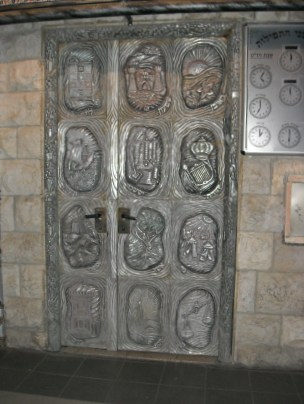
|
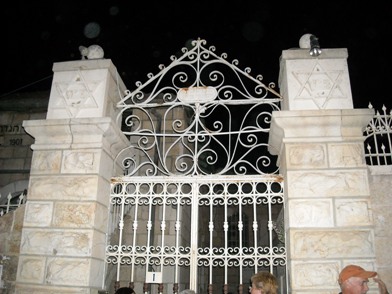
The night we arrived in Jerusalem, our guide took us on an unscheduled walk through an old section of town that was built about 1900. We went by several Orthodox synagogues. Many of the Orthodox synagogues collect money to be used to support their poor. While Orthodox Jews do not serve in the army, they have formed teams to help clean up after bombings. Left: This synagogue had beautiful doors. Right: The synagogue on the right had a sign saying they welcomed Gentiles. |
|
David built some walls around what is referred to as the "City of David" which was south-west of the current walls. Solomon extended them (1 Kings 3:1). Nehemiah (chapters 3 - 7) rebuilt them after returning from Babylon. They were rebuilt by Herod before Jesus was born. Since that time, they were demolished and rebuilt again several times. The current city walls were built by the Muslim Ottoman Empire in 1538. They stretch about 2.8 miles. They are 16 to 49 feet high and are about 10 feet thick. Just a few days after our return, Hebrew University archaeologists announced the discovery and excavation of 230 feet of a 20 foot high wall along with a gatehouse that are believed to be built by Solomon. "The finding is significant because not only does it showcase the incredible engineering abilities of the time, but also it's the first evidence of a structure that correlates with 'written descriptions of Solomon's building of Jerusalem,' Mazar told Science Daily." Wikipedia. Another link contains a video with an interview with Dr. Mazar, the leader of the archaeological dig. For more information about the Old Jerusalem walls and the Dome of the Rock: The Old City Gates, Wikipedia: Old City (Jerusalem), Wikipedia: Dome of the Rock, Bible Places: Dome of the Rock, Wikipedia: Golden gate. |

We are looking across the Kidron Valley at old Jerusalem's East wall. The golden dome is the Dome of the Rock, a major Moslem Mosque. It is built on the location of Herod's temple. |
|
A video showing the East wall. |
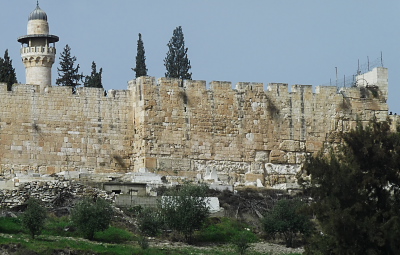
This is a corner of the East wall. |

Above left: This Jewish cemetery is across the Kidron Valley from the wall near the Golden Gate. |
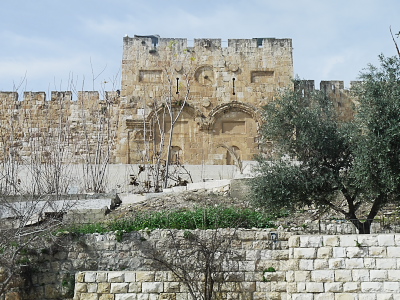
|
|
Above right: The "Golden Gate" was built 6th or 7th century which makes it the oldest of the existing gates. It was sometimes called the "Gate of Mercy" or "Eastern" gate. Arabs call it "Gate of Eternal Life". In ancient times it was known as the "Beautiful Gate". It was sealed by Moslems to prevent the Messiah from entering it. (In Ezekiel 43:1-2, Ezekiel says that he was taken to the east gate "and I saw the glory of the God of Israel coming from the east." After God arrives, in 44:1-3 he says the gate is to remain shut "...because the Lord, the God of Israel, has entered through it."*) Moreover a Moslem cemetery was put in front of it so Elijah, who was thought to proceed the Messiah, could not pass through it. That was a false hope because Elijah's sect was allowed to go into cemeteries of non-Jews. *Thanks to our pastor, John Johnstone, for these references. |
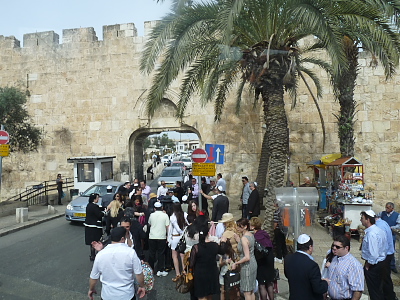
Above: The Dung gate is the southern wall and was rebuilt to be big enough for cars to pass through. It is the closest usable gate to the Temple Mound. In ancient times, it was used to dump refuse out of the city. Right: The Zion Gate is also in the southern Wall. Today it leads to the Armenian and Jewish quarters. The bullet "holes" are from the 6-day war when in 1967 Israel Defense Forces entered and captured the Old City. |

|

The Dome of the Rock behind the east wall. |
|
The Roman Catholic Church of All Nations is located next to a garden that is believed to be the Garden of Gethsemane. It is located at the foot of the Mount of Olives. The Church of Saint Mary Magdalene, a Russian Orthodox church is located higher on the hill. After the last supper, Jesus took his disciples to Gethsemane to pray. His disciples were too sleepy to stay awake and pray with him. Then Judas arrived with a large group with clubs and Jesus was arrested. (Matthew 26: 36-56 and Mark 14:32 -51). Luke says that they went to the Mount of Olives and John says they crossed the Kidron valley to an olive grove. Putting these passages together says that Gethsemane was an olive grove on the Mt. of Olives. These links are some useful references: Wikipedia: Garden of Gethsemane, All About Archaeology: Garden of Gethsemane, and Wikipedia: Church of All Nations, |
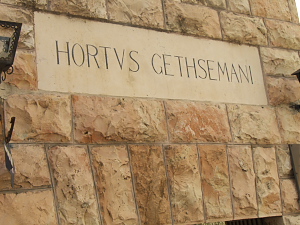
|
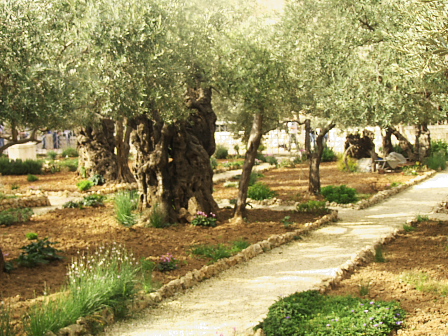
|

An old olive tree in the garden. |
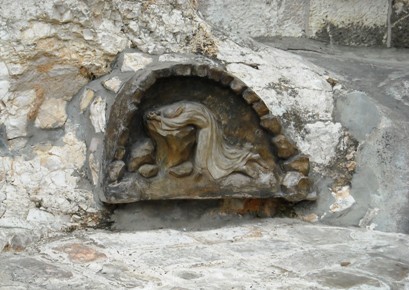
A statue in the garden showing Jesus praying in it. |

The Catholic Church of All Nations, which is next to the garden, maintains it. |

Windows and a dome in the church. |

|

The Russian Orthodox Church of Saint Mary Magdalene with its golden turrets sets a little higher on the Mount of Olives. |

|
|
The full name of this Catholic church is "Church of St. Peter in Gallicantu". The Latin word "Gallicantu" means "cock-crow". The fairly modern church was built in the 1930's over what is believed to be Caiaphas' house where Jesus was taken after his arrest and may have been imprisoned there overnight. In the gospels, we read that after Jesus was arrested, he was taken to the house of the high priest - Caiaphas. He was brought before the Sanhedrin which condemned him to death. While this was happening, Peter was in the court yard outside the house. Afraid, he denied knowing Jesus three times before the cock crowed. (Matthew 26: 57-75, Mark 14: 53:72, Luke 22: 54 - 62, John 18: 12-27.) The next morning Jesus was taken to Pontius Pilot who could officially pronounce the death sentence. Some links to the church and Caiaphas' home include: Wikipedia: Church of St Peter in Gallicantu, and Bible Places: Mt. Zion". |

Above: The Church of Saint Peter in Gallicantu. Right: Our guide points out features of its doors that show Jesus telling Peter that he will deny him 3 times before for the cock crows |

|
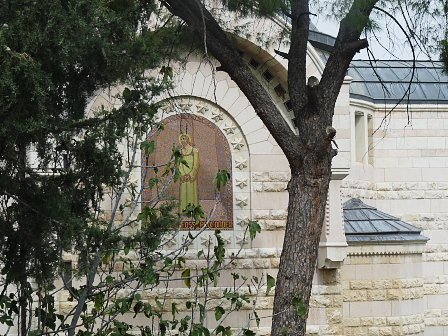
|
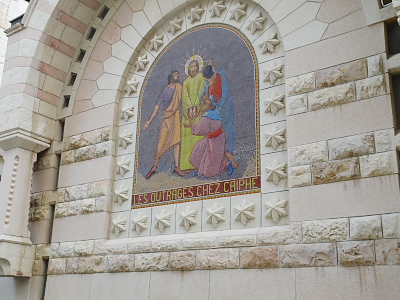
Mosaics above the doors of the church. |

Above: The sign points out some reasons why this is believed to be Caiaphas' home. Right: The opening in the main floor of the church provides a view to Caiaphas' home. |
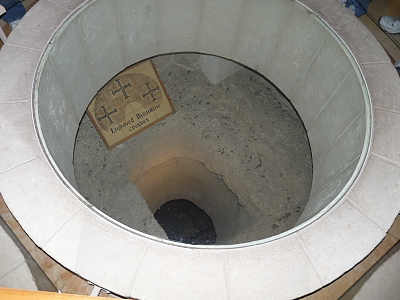
|

Jesus had to be held overnight somewhere before he could be taken to Pontius Pilot in the morning. It is quite possible that he was held in the pit below these openings. |

Paster John led a short devotional in the pit. |
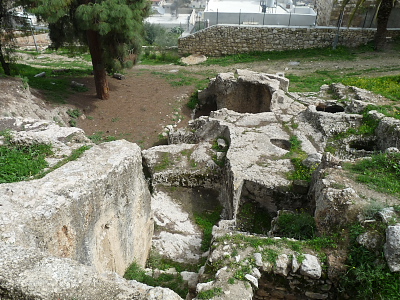
This is believed to be the ruins of the court yard where Peter denied knowing Jesus three times. |
Jerusalem, Day 2, Recommended
Return to the main page
Previous site
Copyright 2010 James and Danielle Brink. Permission is given for non-commercial use.
Last revision: 4/2/2010, Ezekiel reference added 3/25/2010. Updated links: 7/19/2018